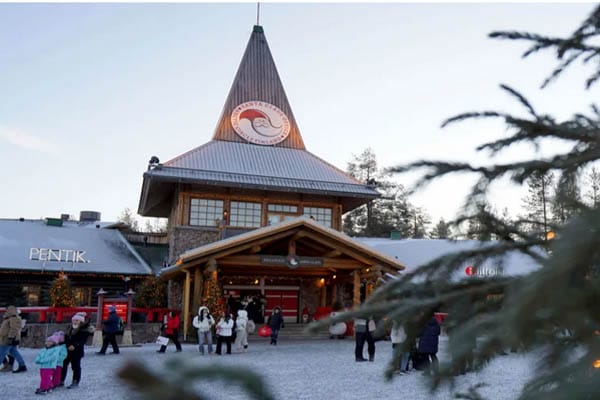
As the cold December air bites and the snow crunches underfoot, countless tourists flock to the enchanting Santa Claus Village, an iconic winter-themed park nestled at the edge of the Arctic Circle. Located in Rovaniemi, the self-proclaimed “official hometown of Santa Claus” in Finnish Lapland, this magical destination promises a festive wonderland where dreams come to life.
Visitors to Santa Claus Village indulge in a range of winter activities: dashing through the snow in reindeer-pulled sleighs, sipping cocktails in frosty ice bars, and, of course, meeting Saint Nick himself. The park attracts over 600,000 visitors annually, with the holiday season being its most celebrated period.
For many, this experience is the fulfillment of lifelong aspirations. “This is like my dream come true,” said Elzbieta Nazaruk, a delighted tourist from Poland. “I’m really excited to be here.”
A Booming Industry with Growing Pains
Rovaniemi has become a global hotspot for winter tourism, drawing visitors from across Europe and beyond. In 2023, the town registered a record 1.2 million overnight stays, a 30% increase from the previous year. Thirteen new flight routes now connect Rovaniemi to cities such as Berlin, Geneva, and Bordeaux, further fueling its popularity.
This Santa Claus Village surge in tourism has thrilled local business owners and city officials alike. Hotels are operating at capacity, and establishments like the 159-room Original Sokos Hotel anticipate another record-breaking year in 2024. “Nordic is a trend,” explained Sanna Karkkainen, CEO of Visit Rovaniemi. “People want to see snow, the Northern Lights, and meet Santa Claus.”
The Price of Popularity
However, not everyone in Rovaniemi is rejoicing. Some residents express concern over “over tourism,” a phenomenon where the influx of visitors strains local resources and infrastructure while negatively impacting the quality of life for locals.
“Tourism has grown so rapidly, it’s not anymore in control,” lamented Antti Pakkanen, a local photographer and activist.
Similar sentiments have echoed across European cities like Barcelona and Amsterdam, where mass tourism has led to overcrowding, degraded cultural sites, and a sense of disconnection for residents. Now, even the remote edges of the Arctic Circle are feeling the pressure.
A significant issue in Rovaniemi (Santa Claus Village) is the conversion of residential apartment buildings into short-term rental accommodations during the peak season. Critics argue this has driven up housing costs, displaced long-term residents, and turned the city center into a transient zone.
Finnish law prohibits professional accommodation services in residential buildings, but enforcement remains lax. “The rules must be enforced better,” insisted Pakkanen.
Mayor Ulla-Kirsikka Vainio, however, points out that short-term rentals provide a lucrative opportunity for some property owners. Striking a balance between the interests of locals and the booming tourism sector remains a challenge.
The Future of Rovaniemi Tourism
Despite concerns, the demand for Rovaniemi’s winter wonderland shows no signs of slowing. The town’s unique charm—its snow-clad landscapes, promise of Northern Lights, and the undeniable magic of Santa Claus Village—continues to draw visitors from around the globe.
“It’s Christmas time, and we would love to see the Northern Lights,” said Joy, a visitor from Bangkok. “Rovaniemi seems to be a good place.”
As the world’s appetite for Arctic experiences grows, Rovaniemi faces the delicate task of preserving its local identity while capitalizing on its status as a holiday destination. Whether through stricter regulations or innovative solutions, the town must navigate the complexities of mass tourism to ensure its allure endures for generations to come.
Apart from this, the tourism department of this place also sponsors a lot of things to celebrate this festival well and in a big way.
For read specific news visit again https://khudaniajournal.com

